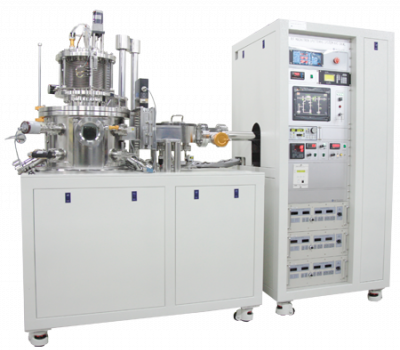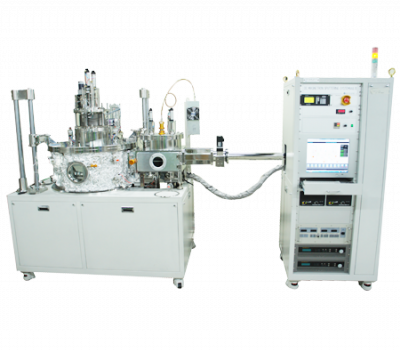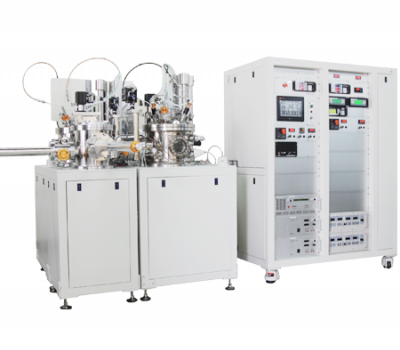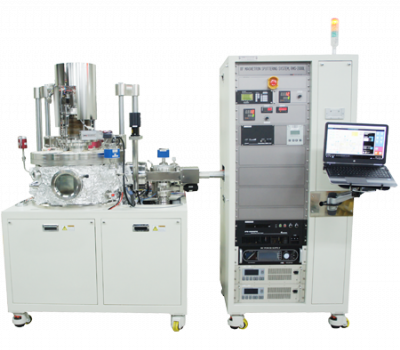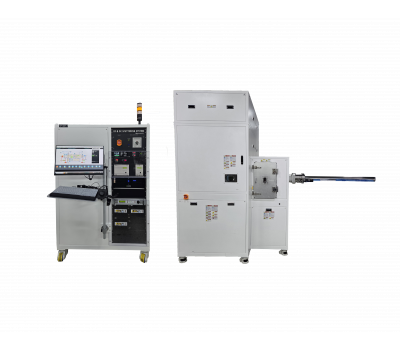-
제품 정보
제품 상세설명
Overview
Sputter deposition is a technique used to deposit thin films of a material onto a surface
(substrate). Atoms and ions of a given material are made to collide. The resulting
momentum exchange disperses incident ions which further perpetuate activity setting
off collision cascades in the target. This activity drives the sputtering process. When
such cascades recoil and reach the target surface with an energy above the surface
binding energy, and atom can be ejected. If the target is thin on an atomic scale the
collision cascade can reach the back side of the target and atoms can escape the
surface binding energy in transmission. The average number of atoms ejected from the
target per incident ion is called the “sputter yield” and depends on the ion incident
angle, the energy of the ion, the masses of the ion and target atoms, and the surface
binding energy of atoms in the target.
Features
≻ Excellent Thickness Uniformity
The KVS Series RF&DC Sputtering System provide excellent thickness uniformity of
resultant films even for substrates that have the same diameter as the sputtering cathode assembly
≻ Full Auto control
These systems provide the ‘auto button’ to user for convenience of user. Fully automated vacuum
process control system.
≻ No Loadlock chamber
Overview
Sputter deposition is a technique used to deposit thin films of a material onto a surface
(substrate). Atoms and ions of a given material are made to collide. The resulting
momentum exchange disperses incident ions which further perpetuate activity setting
off collision cascades in the target. This activity drives the sputtering process. When
such cascades recoil and reach the target surface with an energy above the surface
binding energy, and atom can be ejected. If the target is thin on an atomic scale the
collision cascade can reach the back side of the target and atoms can escape the
surface binding energy in transmission. The average number of atoms ejected from the
target per incident ion is called the “sputter yield” and depends on the ion incident
angle, the energy of the ion, the masses of the ion and target atoms, and the surface
binding energy of atoms in the target.
Features
≻ Excellent Thickness Uniformity
The KVS Series RF&DC Sputtering System provide excellent thickness uniformity of
resultant films even for substrates that have the same diameter as the sputtering cathode assembly
≻ Full Auto control
These systems provide the ‘auto button’ to user for convenience of user. Fully automated vacuum
process control system.
≻ No Loadlock chamber
-
Specifications
제품 Specifications
Specifications
ITEM
SPECIFICATIONS
Process Chamber
Stainless steel
Vacuum Pumping Station
Turbo molecular pump
Loadlock Chamber
Stainless steel
Substrate Heating Unit
SiC / 2”, 3”, 4”, 6”, 8”
Sample Loading/Unloading Unit
Full auto / Semi-auto
Pressure Control Unit
Auto
Vacuum Gauge Controller
ATM ~ 1.0E-10Torr
Gas Supply Unit
MFC (Ar, O2, N2, H2, etc..)
Power Supply Unit
RF / DC / Pulsed DC
Target Size
2”, 3”, 4”, 6”
Film Thickness Uniformity
Less than ±5%
Ultimate Pressure
Less than 5.0E-7Torr
Specifications
ITEM
SPECIFICATIONS
Process Chamber
Stainless steel
Vacuum Pumping Station
Turbo molecular pump
Loadlock Chamber
Stainless steel
Substrate Heating Unit
SiC / 2”, 3”, 4”, 6”, 8”
Sample Loading/Unloading Unit
Full auto / Semi-auto
Pressure Control Unit
Auto
Vacuum Gauge Controller
ATM ~ 1.0E-10Torr
Gas Supply Unit
MFC (Ar, O2, N2, H2, etc..)
Power Supply Unit
RF / DC / Pulsed DC
Target Size
2”, 3”, 4”, 6”
Film Thickness Uniformity
Less than ±5%
Ultimate Pressure
Less than 5.0E-7Torr
-
Options
-
Control
제품 Control
System Control
Vacuum
This screen shows the pumping screen. This
screen consists of each valve, pump action button,
automatic button.The biggest difference from Semi
Auto is the automatic button, so if you proceed with
these buttons in sequence, one sample will
be completed.
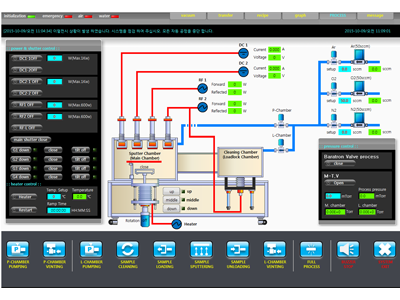
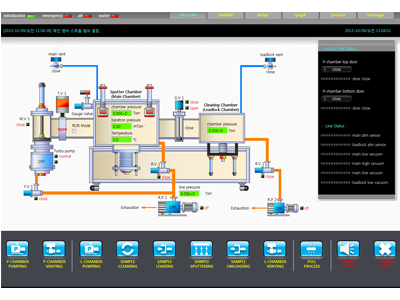
Process
The figure shows the process screen. This screen shows the
buttons that can control the gas flow rate, valve, power etc.
required for the process.
Recipe
The figure shows the recipe screen. This screen
contains boxes for entering the process conditions
required for deposition. Input all the boxes and press
the process button to automatically deposit according
to the input process conditions.

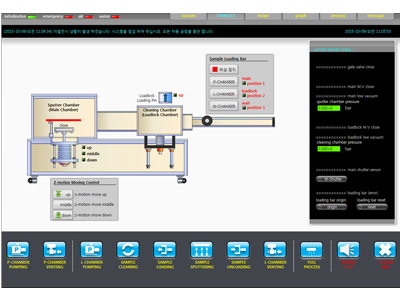
Transfer
The figure shows the Transfer screen. In this screen, there
are buttons that allow you to manipulate the part you will
use to move samples from the load lock chamber to the
process chamber, such as the loading arm, z-motion.
Graph
The figure shows the graph screen. This screen shows
vacuum degree, power amount, deposition rate,
thickness and so on. You can record that data and
make it into a file and compare it with the previous
data.
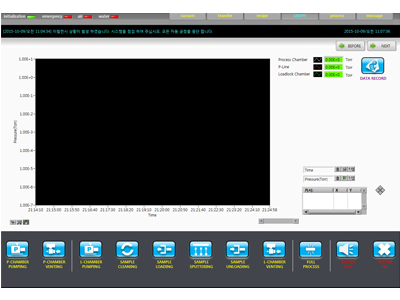
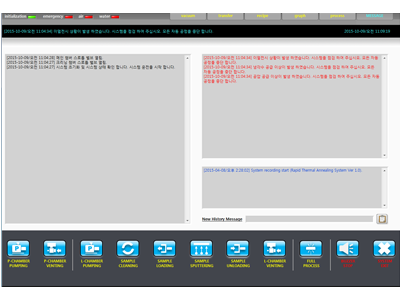
Message
The picture is a graph screen. The picture consists of status message notification messages
System Control
Vacuum
This screen shows the pumping screen. This
screen consists of each valve, pump action button,
automatic button.The biggest difference from Semi
Auto is the automatic button, so if you proceed with
these buttons in sequence, one sample will
be completed.


Process
The figure shows the process screen. This screen shows the
buttons that can control the gas flow rate, valve, power etc.
required for the process.
Recipe
The figure shows the recipe screen. This screen
contains boxes for entering the process conditions
required for deposition. Input all the boxes and press
the process button to automatically deposit according
to the input process conditions.


Transfer
The figure shows the Transfer screen. In this screen, there
are buttons that allow you to manipulate the part you will
use to move samples from the load lock chamber to the
process chamber, such as the loading arm, z-motion.
Graph
The figure shows the graph screen. This screen shows
vacuum degree, power amount, deposition rate,
thickness and so on. You can record that data and
make it into a file and compare it with the previous
data.


Message
The picture is a graph screen. The picture consists of status message notification messages
-
사용후기
-
상품문의
-
배송/교환정보
[배송]
배송 안내 입력전입니다.[교환]
교환/반품 안내 입력전입니다.
선택된 옵션
-
KVS-4000+0원

